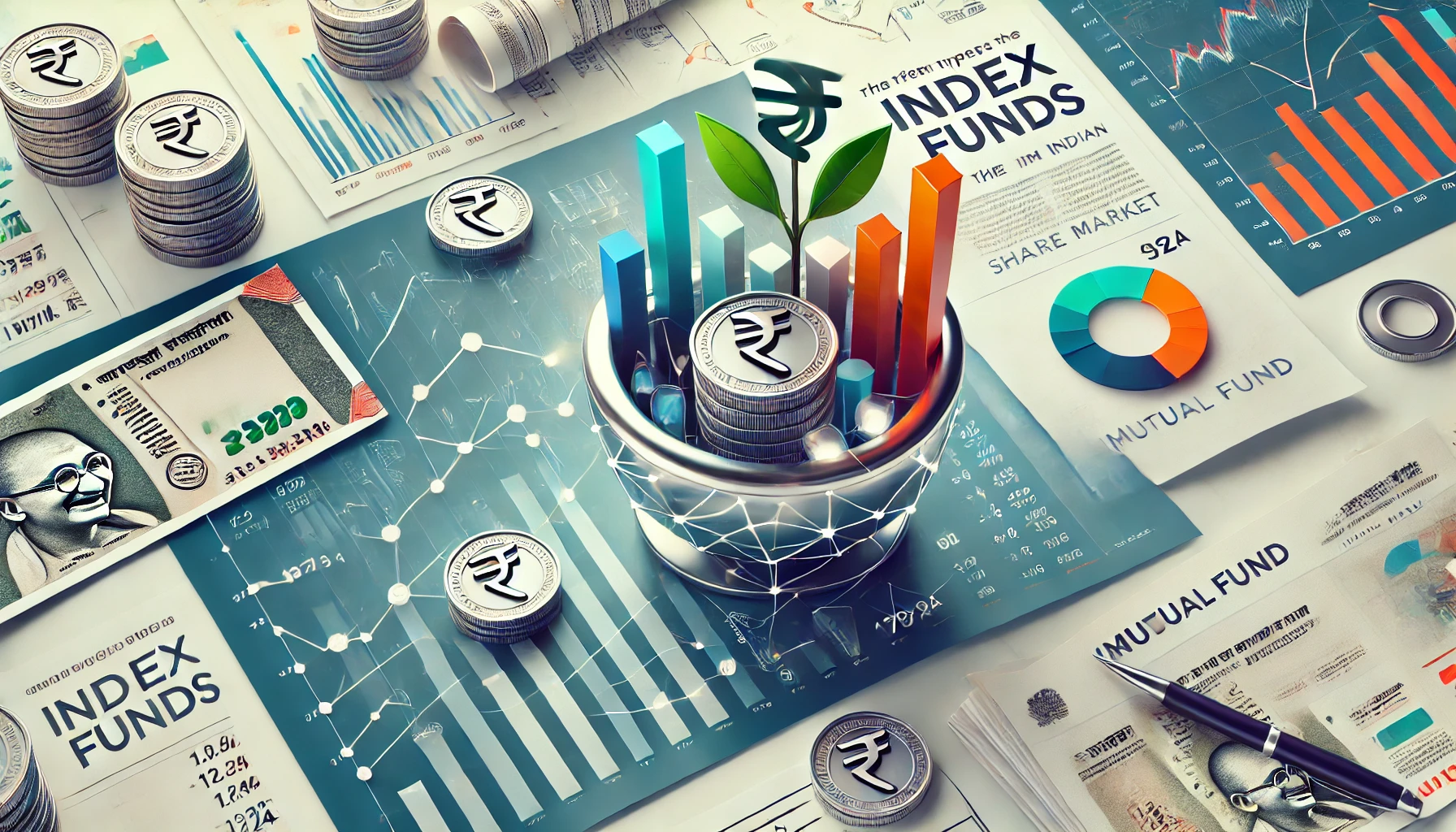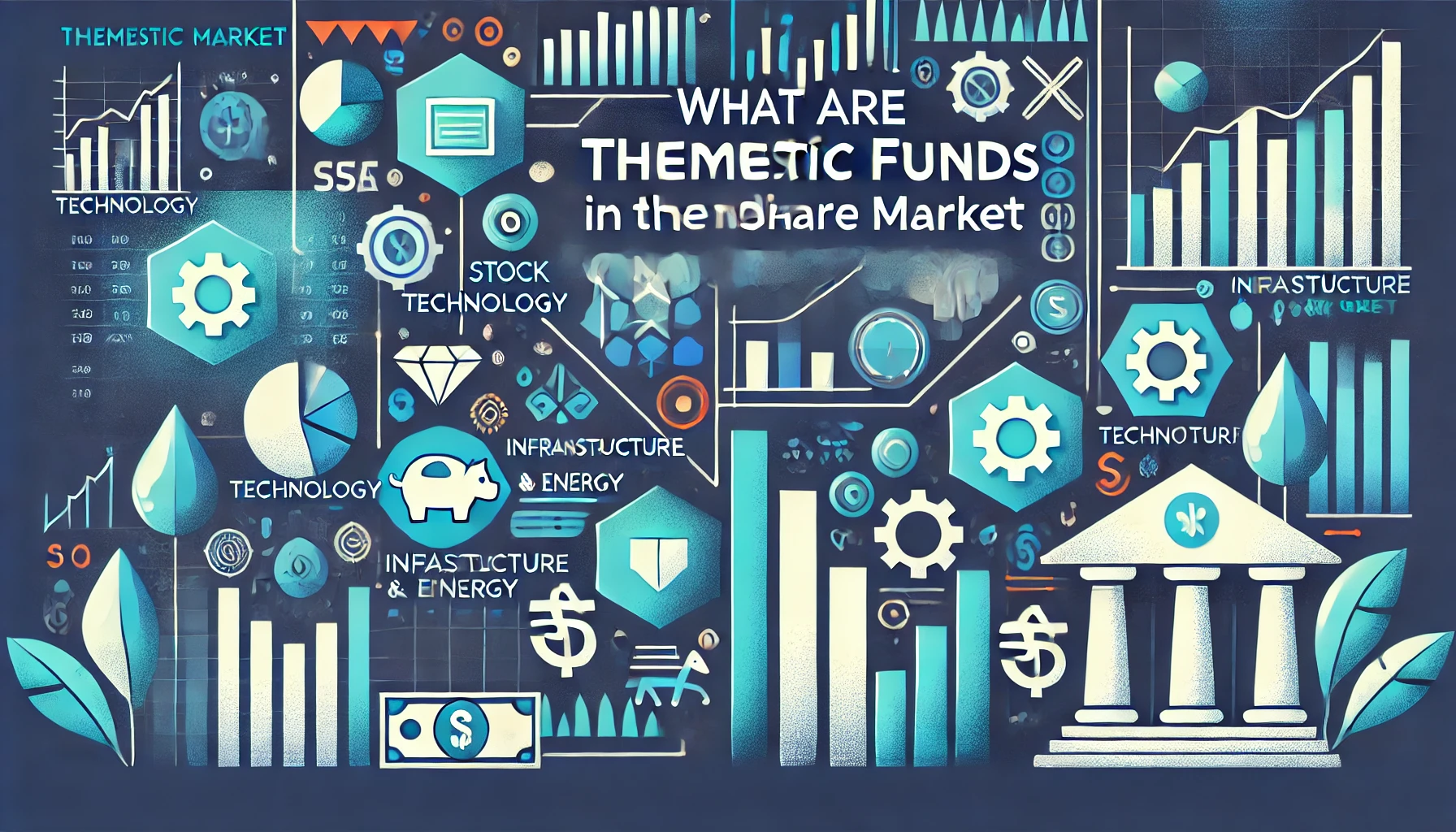In the Indian share market, Thematic Funds have gained popularity as specialized mutual funds tailored around specific investment themes or trends. Unlike conventional mutual funds that focus on sectors, asset classes, or market caps, thematic funds align their portfolio around broader themes, such as technology, energy, healthcare, or even sustainability. This approach offers investors a unique opportunity to capitalize on specific economic or social trends while potentially generating significant returns.
Thematic funds allow investors to channel their capital toward ideas they believe will thrive in the future, making these funds particularly appealing for those with a strong interest in specific sectors or societal shifts.
What is a Thematic Fund?
A Thematic Fund is a type of mutual fund focused on a particular theme or concept, investing across various sectors and companies that align with the chosen theme. Unlike sector-specific funds, thematic funds can span multiple industries, capturing a wide range of companies that benefit from a certain trend or idea.
Examples of common themes in Indian thematic funds include technology-driven innovation, infrastructure development, green energy, healthcare advancements, and rural development.
Why Invest in Thematic Funds?
- Targeted Exposure: Allows investors to focus on trends they believe will have sustained growth.
- Diverse yet Focused: Spans multiple industries under a single unifying theme.
- Innovation-Driven Growth: Ideal for investors who seek high-growth potential in niche areas.
- Long-Term Potential: Captures trends that may shape the economy over the coming years.
| Feature | Benefit |
|---|---|
| Investment Focus | Specific theme, such as technology or energy |
| Portfolio Scope | Spans multiple sectors but within the theme’s framework |
| Risk Level | Higher than broad-market funds due to niche focus |
| Ideal for | Investors with a clear outlook on specific trends or sectors |
Historical Performance of Thematic Funds in India
Thematic Funds often perform based on the relevance and growth of the theme they represent. For example, a technology-focused fund may have performed well over the past decade due to rapid technological advancements. Below is an overview of thematic fund performance over recent years.
Historical Performance Data of Select Thematic Funds (2018 – 2023)
| Year | Technology Thematic Funds (%) | Infrastructure Funds (%) | Energy Funds (%) |
|---|---|---|---|
| 2018 | 15.1 | 8.9 | 12.3 |
| 2019 | 12.4 | 10.6 | 11.8 |
| 2020 | 24.8 | -4.3 | -5.1 |
| 2021 | 28.6 | 16.3 | 20.7 |
| 2022 | 10.3 | 14.5 | 9.2 |
| 2023 | 13.5 | 12.8 | 14.4 |
Benefits of Thematic Funds
Thematic funds offer unique benefits that appeal to various investor types:
- Focused Growth Potential: Invest in trends with strong growth projections.
- Innovation and Future Readiness: Exposure to companies pioneering change in their sectors.
- Portfolio Customization: Allows investors to select themes aligned with their values and beliefs.
- Sectoral Diversification: Despite thematic focus, funds often include multiple sectors, providing some diversification.
Risks of Investing in Thematic Funds
While thematic funds present unique growth opportunities, they also carry certain risks:
- Market Volatility: Sector-specific downturns can significantly impact fund performance.
- Trend Relevance: Themes can go out of favor, affecting long-term returns.
- Higher Risk Profile: Due to limited diversification, thematic funds can be more volatile.
Types of Thematic Funds in India
In India, thematic funds are typically categorized based on the specific theme they follow. Below are some popular types:
- Technology and Innovation Funds: Invest in companies pushing boundaries in technology, artificial intelligence, and automation.
- Infrastructure Development Funds: Focus on companies involved in infrastructure projects such as roads, railways, and housing.
- Green Energy Funds: Invest in renewable energy and environmentally-friendly companies.
- Healthcare and Biotechnology Funds: Focus on pharmaceutical, healthcare, and biotech sectors.
- Rural Development and Consumption Funds: Target companies benefiting from rural consumption and development.
| Fund Type | Example Theme | Key Focus |
|---|---|---|
| Technology Thematic Funds | Innovation, AI | Technology-driven companies |
| Infrastructure Funds | Development projects | Infrastructure-based industries |
| Green Energy Funds | Renewable energy | Sustainable and renewable energy sources |
| Healthcare Funds | Health and biotech | Pharmaceuticals, healthcare advancements |
| Rural Development Funds | Rural growth and consumption | FMCG, agriculture, and rural-focused companies |
Thematic Funds vs. Sector Funds
| Parameter | Thematic Funds | Sector Funds |
|---|---|---|
| Investment Scope | Broad, multiple sectors within a theme | Narrow, typically focused on one sector |
| Risk Level | Moderate to High | High, due to limited sector focus |
| Diversification | Broader, across sectors within the theme | Low, confined to a single sector |
| Ideal for | Investors seeking exposure to trends | Investors focused on a single sector |
Popular Thematic Funds in India
Several Thematic Funds in India have gained traction due to their strong performance and alignment with high-growth areas. Below is an overview of popular thematic funds:
| Fund Name | Theme Focus | 5-Year CAGR (%) |
|---|---|---|
| ABC Technology Fund | Technology | 14.7 |
| XYZ Infrastructure Fund | Infrastructure | 12.2 |
| DEF Green Energy Fund | Renewable Energy | 16.5 |
| GHI Rural Development Fund | Rural Growth | 10.3 |
Investment Strategies for Thematic Funds
Investing in Thematic Funds requires careful analysis and planning. Here are some strategies to optimize returns:
- Long-Term Commitment: Thematic funds often benefit investors who can hold onto investments for extended periods, allowing themes to fully develop.
- Trend Analysis: Investors should evaluate trends to ensure the chosen theme has long-term growth potential.
- Sectoral Balancing: Consider adding thematic funds as a part of a diversified portfolio to balance risks.
- Periodic Evaluation: Reassess the theme’s relevance periodically to ensure it aligns with market trends.
Historical Trends and Economic Impact of Thematic Funds
Thematic Funds have emerged as a preferred choice for investors interested in capitalizing on specific economic and social changes. Here’s a look at a case study to illustrate this:
Case Study: Technology Thematic Funds Growth (2015 – 2023)
| Year | Technology Fund Growth (%) | National IT Sector Growth (%) |
|---|---|---|
| 2015 | 9.2 | 8.1 |
| 2016 | 11.8 | 10.3 |
| 2017 | 15.7 | 12.9 |
| 2018 | 15.1 | 13.2 |
| 2019 | 12.4 | 10.8 |
| 2020 | 24.8 | 18.5 |
| 2021 | 28.6 | 23.3 |
| 2022 | 10.3 | 9.2 |
| 2023 | 13.5 | 11.4 |
This data reveals that thematic funds, such as technology-focused ones, can often outperform the general sector due to targeted exposure to high-growth companies.
Tax Implications of Thematic Funds in India
Thematic Funds in India follow the tax structure of equity mutual funds:
- Short-Term Capital Gains (STCG): Taxed at 15% if held for less than one year.
- Long-Term Capital Gains (LTCG): Gains exceeding INR 1 lakh are taxed at 10% if held for more than a year.
Conclusion
Thematic Funds offer a dynamic way for Indian investors to align their portfolios with specific trends, providing an innovative approach to wealth creation through a theme-based structure. With the potential for high growth and targeted exposure, these funds can complement a well-diversified portfolio for investors looking to capture future economic shifts. However, due to their focused nature, investors should stay informed and choose themes that align with their financial goals and risk tolerance.

What are Dividend Yield Mutual Funds?
Dividend yield mutual funds are designed for investors seeking a steady income source from their …

What Is Children’s Mutual Fund?
Children’s mutual funds are specially designed to help parents and guardians build a secure financial …

What are Alpha and Beta in Mutual Funds?
In mutual fund investing, understanding performance metrics like Alpha and Beta is essential for assessing …

Sovereign Gold Bonds vs Mutual Funds
For Indian investors seeking diverse investment opportunities, both Sovereign Gold Bonds (SGB) and mutual funds …

What Is Risk-Return Trade-Off in Mutual Funds?
In mutual fund investments, the risk-return trade-off is a fundamental concept that helps investors balance …

What is a Mutual Fund Manager?
A mutual fund manager plays a crucial role in the success of a mutual fund, …

Debt vs Equity Funds
Investing in mutual funds offers various avenues, with debt and equity funds standing out as …

What are the Different Types of Index Funds?
Index funds have gained popularity among Indian investors for offering a low-cost, diversified approach to …

What is CAMS KRA?
CAMS KRA (Computer Age Management Services KYC Registration Agency) is a crucial player in India’s …

What is Yield to Maturity?
Yield to Maturity (YTM) is a crucial concept in fixed-income investments, especially in mutual funds …

What are Thematic Funds?
In the Indian share market, Thematic Funds have gained popularity as specialized mutual funds tailored …

What is Broad Market Index Fund?
In the Indian share market, Broad Market Index Funds offer a straightforward, cost-effective way for …

What are Retail Fund?
In the Indian financial market, Retail Funds are a key category of mutual funds designed …

What is Regional Fund?
In the evolving landscape of the Indian financial market, Regional Funds have emerged as a …

Can Mutual Funds Change Expense Ratio?
Investing in mutual funds involves paying various fees, one of the most important being the …

What is the Inverted Yield Curve?
In financial markets, the yield curve is a key indicator that investors and economists use …

What are Dynamic Asset Allocation Funds?
Dynamic asset allocation funds, also known as balanced advantage funds, are becoming increasingly popular in …

What are Short Term Capital Gains on Mutual Funds?
Investing in mutual funds has become an increasingly popular way for investors to diversify their …

What are Corporate Bond Funds?
Corporate bond funds are a type of debt mutual fund that invests primarily in high-rated …

What Are Money Market Funds?
Money Market Funds (MMFs) are a type of mutual fund that invests in short-term debt …

What is a Fund of Funds?
A Fund of Funds (FoF) is a mutual fund that invests in other mutual funds …

What is a Credit Risk Fund?
A credit risk fund is a type of debt mutual fund that primarily invests in …

What are Gold Funds?
Gold funds are a type of mutual fund that invests in gold-related assets, including gold …

What is Counterparty Risk?
In the world of investments, especially in Indian share market mutual funds, the concept of …

What is a sinking fund?
In the world of finance and investments, planning ahead for future liabilities is crucial for …

What is IDCW in a Mutual Fund?
Investing in mutual funds offers several options for investors looking to grow their wealth over …

What are growth funds?
Growth funds are a type of mutual fund that primarily focuses on capital appreciation by …

CAGR vs Absolute Returns
When investing in mutual funds, understanding your returns is essential to make informed decisions. Two …

What is a Capital Protection Fund?
A Capital Protection Fund (CPF) is a type of hybrid mutual fund designed to safeguard …

What Is Rupee Cost Averaging in Sip?
Rupee Cost Averaging (RCA) is a systematic investment strategy used in mutual fund investments, particularly …

What are Gilt Funds
Investing in mutual funds can be an excellent way to grow your wealth while managing …

What is Target Maturity Funds?
Target Maturity Funds (TMFs) have gained attention in the Indian share market, offering a unique …

What is KIM?
When investing in Indian mutual funds, investors often come across a document known as the …

Trailing Returns vs Rolling Returns
When analyzing mutual fund performance, understanding returns is crucial for making informed investment decisions. Two …

What is Hybrid Mutual Fund?
When investing in mutual funds, you typically aim to find the right balance between risk …

What is XIRR?
Investing in mutual funds is a popular choice for many investors in India, thanks to …

What is the Sharpe ratio?
In the world of mutual fund investing, one of the most crucial aspects to consider …

What is AMFI?
The Indian mutual funds industry has grown exponentially over the past two decades. This growth …

What is Rolling Returns?
Investing in mutual funds requires understanding various performance metrics to make informed decisions. One such …



















